Be sure to Click LIKE at the bottom of this article, and share it everywhere!! By Craig Andresen – The National Patriot and Right Side Patriots – Commentary
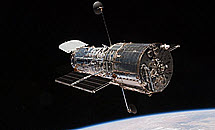 Back in 1990, the Hubble Space Telescope was launched, and after being fitted with glasses due to a rather unfortunate mix-up between standard and metric measurements, we started seeing things that simply astounded us. We saw the cosmos with a clarity never before imagined.
Back in 1990, the Hubble Space Telescope was launched, and after being fitted with glasses due to a rather unfortunate mix-up between standard and metric measurements, we started seeing things that simply astounded us. We saw the cosmos with a clarity never before imagined.
Hubble has done more to enhance our knowledge and understanding of the universe since 1990 than Galileo has since 1609. The images we have gazed upon with rightful wonder thanks to Hubble have been magnificent, awe-inspiring and breath-taking. Among other things, Hubble has helped pin down the age for the universe now known to be 13.8 billion years, roughly three times the age of Earth.
Because of Hubble, we’ve discovered two moons of Pluto, Nix and Hydra. Hubble has helped determine the rate at which the universe is expanding, discovered that nearly every major galaxy is anchored by a black hole at the center and created a 3-D map of dark matter. Hubble has found exoplanets and helped determine their composition. Hubble let us watch a comet slam into Jupiter, found water vapor erupting off the surface of Jupiter’s moon Europa and for the very first time, the effect of gravitational lensing on a distant exploding star.
Over the past 32 years, Hubble has made some 1.3 million scientific observations and 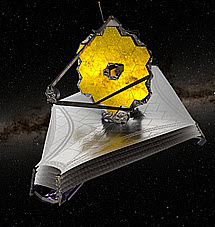 returned to us some 1 million photographic images.
returned to us some 1 million photographic images.
Now, there’s a new telescope in space. The James Webb Telescope, and it’s bigger, better, and further away that any orbiting observation platform ever created. Galileo would be astounded.
The Webb Telescope is parked 1 million miles away from Earth with an array of mirrors that dwarfs Hubble and a package of scientific instruments and capabilities that literally would put Hubble to shame if Hubble had any reason to be ashamed…which it doesn’t. Webb is massive and has a 5 layer heat shield the size of a tennis court to keep it protected from the blistering heat of the sun. Webb is large enough to cover an area 15 times the size of what Hubble can handle, with a stunningly better spatial resolution than is available from any other telescope. The Near-Infrared Camera (NIRCam), the Near-Infrared Spectrograph (NIRSpec), the Near-Infrared Imager and Slitless Spectrograph (NIRISS), and the Mid-Infrared Instruments on Webb can look further back in time and space with such precision and detail that we will be able to learn the chemical make-up of distant exopolanets to see if any might sustain life, and we will be able to learn about our universe all the way back to just millions of years after the Big Bang.
Just a couple of weeks ago, the first full-color images from the James Webb Telescope were released to the public and they were staggering. What astounded us from Hubble now blows our minds from Webb. That the image below as an example. Here is the Carina Nebula as seen by Hubble. Astounding.
Now here is the Carina Nebula as seen by the James Webb Telescope.
Mind blowing.
Look again. Look at what the arrow points to below.
That is a reasonably new star by cosmic standards but it’s doing something impressive. It’s moving through the nebula like a comet. That star is traveling at a high velocity and in its wake, it’s leaving a tail millions upon millions of light years long. We couldn’t even see it from Hubble, and yet…there it is in the Webb image.
The James Webb Telescope is knowledge.
Thousands of people well above my pay-grade are going to spend decades learning from the Webb Telescope, and they are already learning things we either never knew, or only knew in theory. They are looking back in time, billions of years back, and many more billions of light years into the past of our universe. They will gain knowledge that will further our understanding of the universe, and they will learn more about our place in it.
A couple of weeks ago, I posted to Facebook a couple of the first Webb images and among the comments was one from Matthew Edward Hayward… “Pretty cool, but was it worth the expense?”
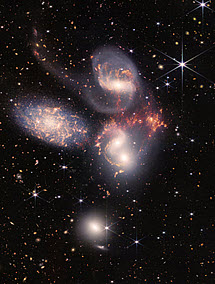 Matthew believes funding NASA, and the $10 billion dollars spent over the past 20 years on building the James Webb Telescope is a waste of money. Let me put it this way…The cost of furthering our understanding of the universe and our own solar system, in the case of the Webb telescope is $10 billion dollars. The price of remaining ignorant is free. To those seeking knowledge, yes, it is worth the expense. Those who would rather be blissfully ignorant ask…“Was it worth the expense?”
Matthew believes funding NASA, and the $10 billion dollars spent over the past 20 years on building the James Webb Telescope is a waste of money. Let me put it this way…The cost of furthering our understanding of the universe and our own solar system, in the case of the Webb telescope is $10 billion dollars. The price of remaining ignorant is free. To those seeking knowledge, yes, it is worth the expense. Those who would rather be blissfully ignorant ask…“Was it worth the expense?”
Matthew then proceeded to go to the typical fall-back line of thought always taken by those who don’t like spending money on things they can’t understand…”how many lives could have been saved with that money? I bet if you talked to the family members of those who died from starvation or lack of medical treatment due to finances would disagree with you. Personally, I’m opposed to spending money we don’t have, no matter what it’s being spent.”
That line of thought is a head-scratcher. How many lives could have been saved by spending money we don’t have on something Matthew thinks would be a better way to spend the money? In other words, Matthew is against spending money we don’t have unless we spend it on what HE wants to spend it on.
How many lives could have been saved with the $10 billion spent on the Webb Telescope? There is no way to quantify any answer to such a question, which is why it is always the fall-back question asked by those who have no desire to seek knowledge. The contributions from our space program to everyday life can sometimes not be measured immediately upon paying for them.
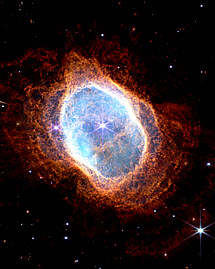 Did you know that NASA’s digital signal technology, originally used to recreate images of the moon during the Apollo missions, is the underlying technology that makes CAT scans and MRIs possible.
Did you know that NASA’s digital signal technology, originally used to recreate images of the moon during the Apollo missions, is the underlying technology that makes CAT scans and MRIs possible.
The pyrotechnic mechanism used to detach a space shuttle from its rocket boosters after launch is the same used in Lifeshears, but in a smaller scale. Lifeshears are a tool that can be used in emergency situations to cut into cars or collapsed buildings to rescue people trapped inside.
Matthew mentioned starvation…well…The ability to cook food on long space missions is no longer impossible with the invention of 3D food printers. That technology is now being refined for commercial use for the production of chocolates and other confections as well as to create nutritious foods for diabetics and others with specific dietary needs.
In the sealed, artificial environment of a spacecraft, attempts to grow plants have led to ethylene buildup. NASA invented an air purifier for the International Space Station that is now used widely on Earth – everywhere from restaurants, to hospitals, to refrigerators – to remove ethylene, which hastens decay, as well as other particulates and pathogens.
Here’s more life-saving tech from NASA and the money we’ve “wasted” on it. Needing to monitor astronauts’ vital signs in space, the Goddard Space Flight Center created monitoring systems that have been adapted to regulate blood sugar levels and release insulin as needed.
When you consider all of these things and so many more…how many lives have been 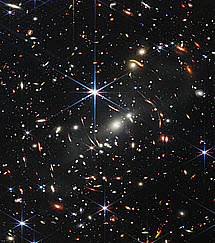 saved because of NASA’s quest for knowledge? Again, you can’t quantify an answer…but was it worth the expense? Yes.
saved because of NASA’s quest for knowledge? Again, you can’t quantify an answer…but was it worth the expense? Yes.
Matthew naturally had a come-back to that information and commented, “it sounds like you’re making an argument that spending a ton of money to do exploratory research has in the past provided unintended benefits and therefore it’s justified to continue to spend tremendous amounts of money we don’t have on things that have no direct benefit to us.”
Maybe think of it this way…how long did Dr. Christiaan Barnard study, and how much money was spent on research, developing medications, instruments and all that went into his endeavor before he performed the first human heart transplant in 1967? How many taxpayer dollars were spent making THAT possible? How many items used in that surgery were invented for other purposes before being used for transplanting a human heart? How many OTHER lives could have been saved had that money gone to something else?
When the first successful heart transplant, in a dog, at Stanford University in California took place in 1958, one wonders how many people like Matthew thought THAT was a waste of money.
Here’s the deal…over the past 55 years, heart transplants have become relatively easy to  do, but finding donor hearts is still very hard. People needing a heart transplant now have a better option while they wait for a donor heart. It’s a heart pump that keeps their blood circulating while they wait. Drs. DeBakey and Noon, heart surgeons, wanted a small pump that could be implanted in the body that would do the job…and where did they go to find such a pump?
do, but finding donor hearts is still very hard. People needing a heart transplant now have a better option while they wait for a donor heart. It’s a heart pump that keeps their blood circulating while they wait. Drs. DeBakey and Noon, heart surgeons, wanted a small pump that could be implanted in the body that would do the job…and where did they go to find such a pump?
NASA.
The implantable axial rotary heart pump was developed at Johnson Space Center in 2002 from the design used to move fuel through the tanks of the Space Shuttle.
Obviously, money spent on the Webb Telescope, just as it has always been with NASA, is money well-spent as it always increases our knowledge, so why is it that some people just don’t want to spend that money?
I think the answer is clear.
The idea of knowledge scares them. The idea that the further we push the boundaries of our knowledge of the universe, the further we look out into space and the further we look back in time brings us closer to the proof that we are not alone in the universe. It’s a very upsetting notion to some. They just can’t come to grips with the mathematical certainty that out of countless billions of galaxies and the untold trillions of planets in those galaxies we cannot possibly be alone.
When that proof is in hand, and it will be someday, it will upend the religious order of those who would prefer to remain blissfully ignorant. The idea that the Earth revolved around the sun, that the world was round, and even Newton’s laws of gravity turned the religious world order upside down in their time, but all those and so many more discoveries have been proven true.
We simply don’t know what’s out there in the vastness of the universe or how many civilizations have existed out there in the distant past let alone exist today, but we do know what the building blocks of basic life look like, and with the Webb Telescope we’ll be able to identify those elements around distant stars.
It’s knowledge.
We believe that civilization as we know it today arose on Earth roughly 6,000 years ago even though we know the Earth has been here for 4.5 billion years. To be honest, we can’t even say for sure that civilization as we know it today was even the first time civilization arose on our own planet.
Every element in the periodic table, aside from hydrogen, is essentially stardust and the human body, when you break it down by elements is roughly made up of 93% stardust. Think about that, and then consider this…
 When we point the James Webb Telescope into the vastness of the universe to look back in time at galaxies and stars, we are really looking into a mirror at our own elemental reflections.
When we point the James Webb Telescope into the vastness of the universe to look back in time at galaxies and stars, we are really looking into a mirror at our own elemental reflections.
The Webb of knowledge…indeed.
Copyright © 2022 Craig Andresen / thenationalpatriot.com all rights reserved
************************************************************************************************
For more political commentary please visit my RIGHT SIDE PATRIOTS partner Diane Sori’s blog The Patriot Factor to read her latest op-ed A Failed Presidency Exposed
*************************************************************************************************

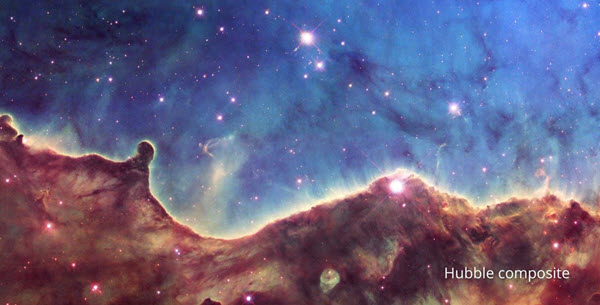
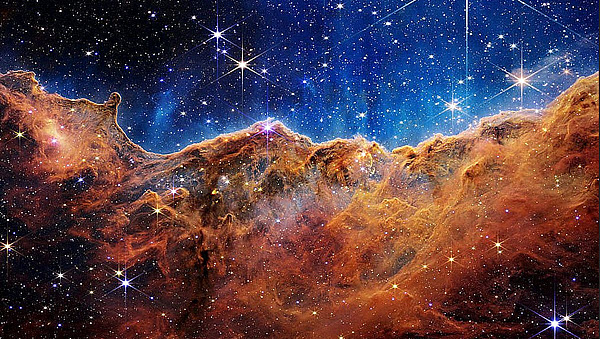
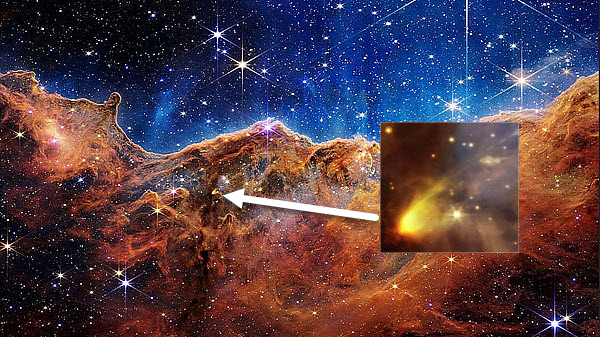
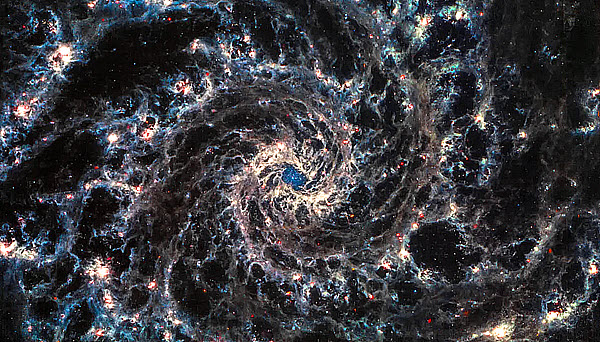




You have absolutely no expertise in presenting the reality of space wonders
You do not even have a telescope.
Stop Babbling lunacy as you try do sadly to be pertinent.
The Webb telescope does not have any cameras that can take color pictures. It only has infra-red cameras
You are spreading a false reality as you drink from the glass of disinformation. The start spikes are based upon upon structure not view.
From the Author – Craig Andresen: As stated in Forbes, “Webb’s images are moved up the electromagnetic spectrum from a part we can’t perceive into the visible light part that we can see.
They take mono brightness images from Webb using up to 29 different narrowband filters, each of which detects different wavelengths of infrared light. They them assign each filter’s collected light a different visible color, from the reddest red light has the longest wavelength) to blue (which has the shortest wavelength). They then create a composite image.
Is that cheating? All the engineers are doing is taking radiation from one part of the spectrum our eyes can’t see and shifting it into another part of the spectrum we can see.
It’s like playing a song in a different key.
Besides, all cameras—including your smartphone’s camera—use filters to take the images you see. No, not Instagram filters, but individual red, green and blue filters that, when combined, produces a visible image that looks “real.”
If you think Webb’s images are not real then you also have to think that your own smartphone’s photos are fake. “
As for the star spikes (you called them “start spikes) I never mentioned them in the commentary, however, they are the result of the shape of the mirrors on the Webb Telescope. It’s a refraction of light.